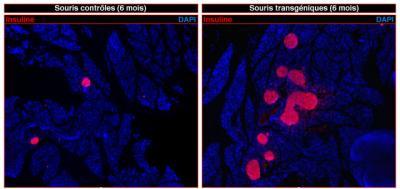They have also shown that any pancreatic β cells can be regenerated several times and that chemically-induced diabetes in mice can thus be "treated" repeatedly. The challenge for the researchers is now to show that these procedures can be applied to humans.
Their work is published online in the Developmental Cell journal dated 27 June 2013.
Type I diabetes, characterised by the selective loss of pancreatic, insulin-producing β cells, is a condition that affects more than 30 million people worldwide. Despite current treatments, type I diabetic patients have a life expectancy that is reduced by five to eight years. It is in this context that the Avenir "Diabetes Genetics" team have been working to develop new approaches designed to regenerate these cells.
In 2009, researchers at the Valrose Biology Institute (Inserm/University of Nice Sophia Antipolis) managed to convert glucagon-producing α cells into β cells in young mice. Currently, thanks to the use of transgenic mice, they have shown the mechanisms that result in this change of cell identity. These are the very cells of the pancreatic ducts that can be mobilised and literally transformed into α, then into β cells, a process that works at any age. The transformation is obtained through the forced activation of the Pax 4 gene in the α cells of the pancreas. The resulting cascade of events causes the manufacture of brand-new β cells, thanks to a revival of the development genes. Throughout this process the α cells are regenerated and gradually adopt the profile of β cells. This means that the pancreas has a virtually inexhaustible source of cells capable of replacing the β cells.

Left: The pancreas of control mice (non-diabetic) is shown.Right: The pancreas of transgenic mice demonstrates massive regeneration of insulin-producing β cells (colored pink) following chemical induction of diabetes.
(Photo Credit: © Patrick Collombat / Inserm)
By artificially creating type I diabetes in mice, "we also showed that all the pancreatic β cells could be regenerated at least three times using this mechanism. Diabetes, induced in this way in the mouse, can be literally "treated" multiple times thanks to the new stock of functional, insulin-producing β cells" explains Patrick Collombat, INSERM research director and principal author of the study.
These promising results obtained in the mouse suggest that the pancreas contains cells that can regenerate several times those β cells lost in type I diabetics.
"We are currently working on the possibility of inducing such regeneration by using pharmacological molecules. Thanks to this new data, we shall be concentrating in future years on determining whether these processes can also be made to work in humans, a real challenge in offering better treatments for type I diabetes", he concludes.
Source: INSERM (Institut national de la santé et de la recherche médicale)